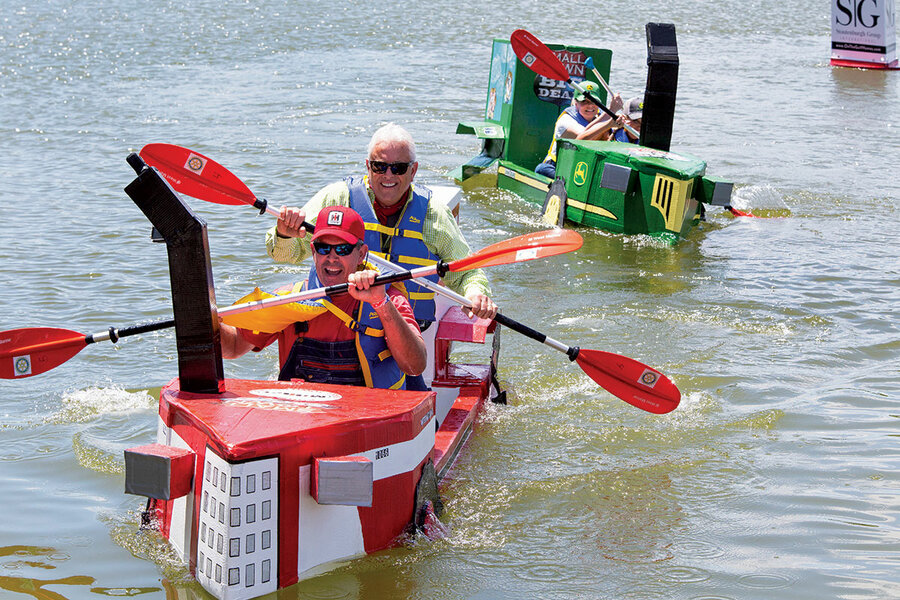In Pictures: At the cardboard boat regatta, sinking is part of the fun
Loading...
| Cape Coral, Fla.
It’s race day, and spectators are filling the stands and lining the hillside around a small lake in Seahawk Park in Cape Coral, Florida. On the one hand, they’re here to see a boat race. On the other hand, they’re also here to see which boats sink the most spectacularly.
Because at the Cape Coral Cardboard Boat Regatta, boats don’t just compete against each other, but also against the elements. (One of the secrets to staying afloat – and winning over the crowd, which craves creative designs – is paint.)
Why We Wrote This
What brings a community together? For one Florida city, creativity, teamwork, and a little friendly competition serve to make the annual cardboard boat regatta a rollicking success.
Spectators, participants, and judges view the 14 entries on dry land and vote – on design, team spirit, construction, and decorations. Tony Fonzi, captain of a paddle-wheel boat, says it took 30 people working hundreds of hours to build his vessel.
Pat Wood, when asked why he participates, says, “We’re just a bunch of old guys with disposable income and some time on our hands.”
Rotary Club President Bob Welsh declares, “It’s just a good family day.” Everyone gets a medal or trophy.
Pat Collins, another of the boat builders, says, “The best thing is bragging rights!”
The Titanic sinks. Again. But this time no icebergs are involved. Instead of night in the North Atlantic, it’s a sunny 90-degree day in southern Florida, and the fatal flaw is soggy cardboard. It’s all part of the fun at the annual Cape Coral Cardboard Boat Regatta, which got its start in 1994.
Boats made of cardboard? Yes, and they do float (for a while). The Rotary Club of Cape Coral, which sponsors the event, has extremely detailed instructions for boat building with corrugated cardboard on its website. There are lots of rules and pointers. One of the secrets, it seems, is paint.
On race day, spectators fill the stands and line the hillside around a small lake in Seahawk Park to watch teams and individuals compete in timed heats around a short course. There is talk of the police boat having to encourage an alligator to move away from the action. (This is Florida, after all.) Events are divided into boat size, team size, and age of, and/or number of, paddlers.
Why We Wrote This
What brings a community together? For one Florida city, creativity, teamwork, and a little friendly competition serve to make the annual cardboard boat regatta a rollicking success.
Before the boats hit the water, spectators, participants, and judges view the 14 entries on dry land and vote – on design, team spirit, construction, and decorations. The most impressive is the paddle-wheel boat created by the New Residents’ Club. Tony Fonzi, captain of said boat, says it took 30 people working hundreds of hours to build it.
Pat Wood, when asked why he participates, says, “We’re just a bunch of old guys with disposable income and some time on our hands,” as he shows off the decorative snake, gator, and fish that “the wives” made for his team’s airboat, The Polar Bear Express.
Rotary Club President Bob Welsh declares, “It’s just a good family day.” Everyone gets a medal or trophy.
Pat Collins, another of the boat builders, says, “The best thing is bragging rights!"















